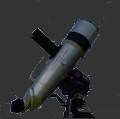Mounting Binoculars for Astronomy
Mounting Small Binoculars
The shake you get when hand-holding a binocular is not usually obtrusive on large objects (e.g. Orion Nebula, Andromeda Galaxy), but is infuriating on double stars that test the binocular (e.g. Albireo or δ Cephei for a 10×50). Most people start out with binoculars similar in size to a 10×50 and consider ways of mounting these on a photo tripod, usually by some sort of L-bracket, unless the binocular has a built-in mounting bush:

Central Image
Top Row, L to R: Hinge clamp, Standard L-bracket, Roof-prism L-bracket, Universal Astronomics custom L-bracket
Bottom: ¼" mounting bush on prism housing
Hinge clamp: As the name suggests, it clamps onto the central hinge of Porro-prism binoculars. May be unsuitable if the binocular has a wide focusing "band" as opposed to a narrow focusing wheel. The Minolta one shown in the image is no longer commercially available, but there is a very good one made by Opticron which more than adequately serves the purpose.
Standard L-bracket: Screws into the ¼" mounting bush at the distal end of the central hinge, if the binocular is equipped with one. Many cheap modern ones are made of plastic. They are flex a great deal and are teriible to use (but can be improved by epoxy-ing a decapitated 6mm bolt into the recesses on either side). Good ones can be obtained from Amazon UK and Amazon USA.
Roof-prism L-bracket: The bent aluminium "L" bracket in the image above is available with recesses for the objective tubes of roof-prism binoculars (which are closer together than in Porro-prism binocs). However, many modern mounting brackets, such as those shown in the links above, are suitable for both roof-and porro-prism binoculars.
Universal Astronomics custom L-bracket: Similar to above, but is a proprietary bracket that fits the Universal Astronomics mounts.
¼" mounting bush on prism housing: Rarely seen nowadays. Care needs to be taken that the
tripod head allows the binocular to be mounted in such a manner that the observer's nose does not foul the tripod head! Offers no facility for tilting the binocular side-to side.
Monopods
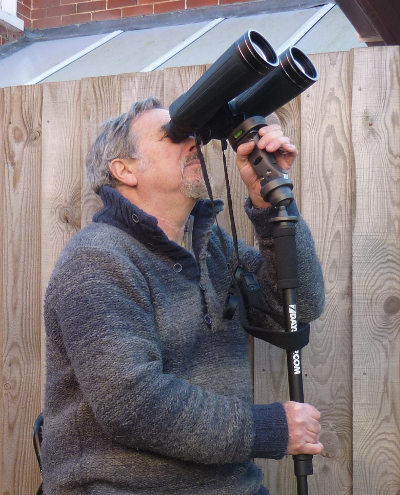
A standard monopod is useful as a mount for small and medium binoculars. The one shown is holding a 2.5kg 15×70. I have added a trigger-grip ball-head to it; this changes it from being useful to being a joy to use from a seated or semi-reclining position. If a monopod is not equipped with some form of moveable head, the entire monopod may have to be moved, and extended or collapsed, as you slew from one object to another. With a moveable head, this is enormously reduced; a trigger-grip ball-head makes it very much simpler, as you don't need to constantly adjust tension screws with cold or gloved fingers. The other hand can control monopod length. This very soon becomes intuitive.
This has become my favoured mount for the 15×70 in the photograph, which has recently become my "grab-and-go" choice when I want to do some quick observing.
An inexpensive monopod such as this one is adequate and has sufficient height to be used standing. Because the monpod will not be vertical all the time, especially when seated, a spiked foot is ideal. A higher quality monopod like this one has adjustable clamps and will probably last longer, so may be a better purchase in the long term. It is possible to replace the rubber ferrule with a spiked foot.
Trigger-grip ballheads similar to the one shown in the photographs can be obtained from Amazon UK. If you need a tripod, you can also buy one complete with a reasonably sturdy tripod here. The head holds the 2.5kg binoculars shown in the image below although, because the centre-column is not geared, it is better-suited to lighter binoculars. The tripod is shown fully extended; I can use it reasonably comfortably up to an elevation of about 60° — I am 1.78m tall, if you need a height reference.
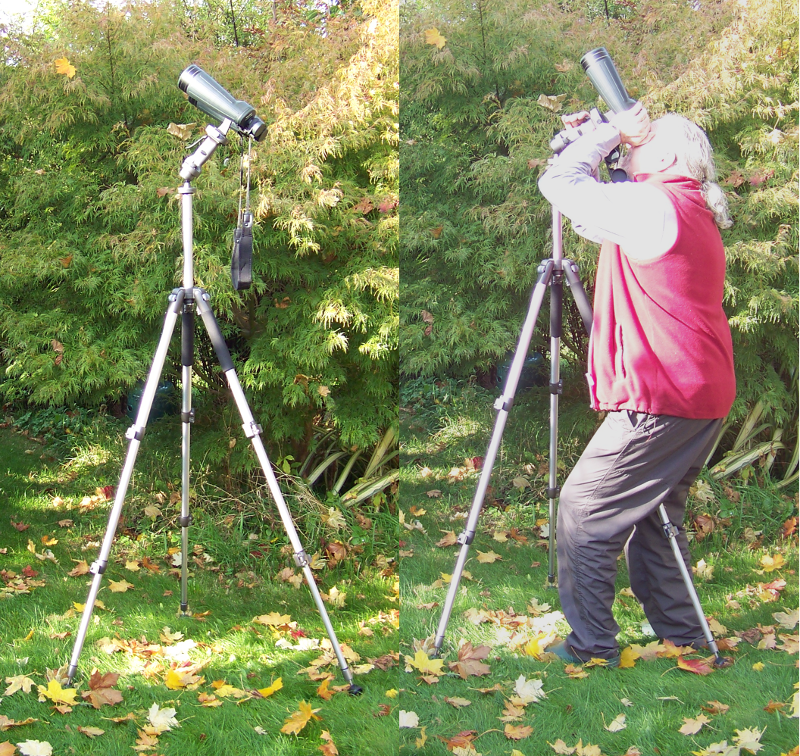
In the USA, these trigger grip heads seem to be more economical to by separately from Amazon USA. However, the combo with the tripod is also available here and here. If you are buying it separately, you will also need one of these adaptors unless your monopod/tripod has a 3⁄8" mounting screw.
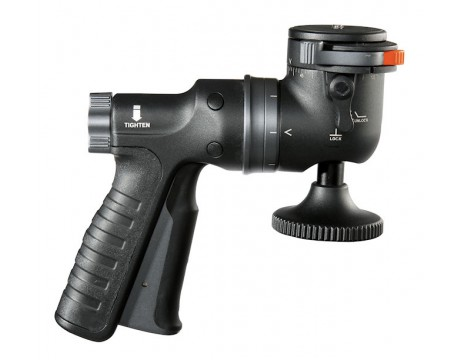 NB: Do not be tempted by the "pistol grip" heads that look like this — they may be OK for photography, but they are extremely awkward to use for astronomy!
NB: Do not be tempted by the "pistol grip" heads that look like this — they may be OK for photography, but they are extremely awkward to use for astronomy!
Lastly, you will need a sturdy "tripod adaptor" for your binocular. See the suggestions given above.
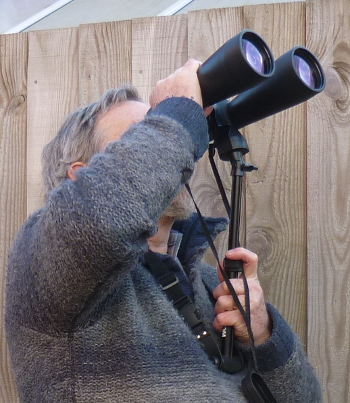
An adaptation of the monopod is the "neckpod". This is a monopod that is suspended from a broad strap around
the neck. The one shown is intended for small cameras, but is quite usable for the 1.3kg 15×70 shown
in the photograph. Although it is not as steady as a proper monopod, and is being used with a weight at least
twice as great as what it was designed for, it is a noticeable improvement on hand-holding.
Most of the weight of the binocular is taken by your torso, so it is far less tiring than hand-holding. However,
it can be quite fiddly to use although, once you get the tension in the tilt head set to something usable, all
you need to adjust is the monopod length when you change elevation.
Note: The tilt head cannot be tightened enough to support the cantilevered weight of the binocular,
but you don't want it to be immovable, or it makes it difficult to slew to objects of different elevations. You
need to set it to a tension that enables you to move the binocular, but not so loose that it swings freely if
you remove your hand from it.
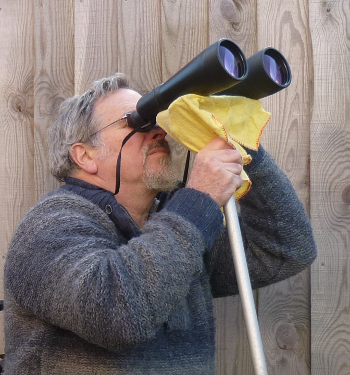
Serviceable monopods can be concocted from household items. This is my ancient "bodge-o-pod". It is an extensible
window-cleaning brush and squeegee that has a tiltable head. I simply place a clean duster over the business end
and rest the binocular on it. It adds stability, but you need to secure the binocular to it if you are observing
at high elevations; I use a bungee cord for this purpose.
You can even use a standard domestic broom or garden rake as a monopod,
but these will not have the "advanced extend and tilt features" that are included free with a cheap window cleaner!
Tripods and Heads
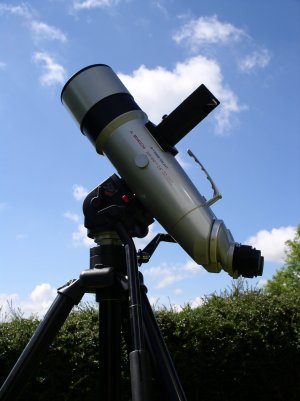
The tripod and head should be chosen with care. As the binocular is pointed
at higher altitudes, the height of the eyepieces decreases. Simultaneously, the
height of your eyes increases as your head is tilted back. Some form of height
adjustment is therefore necessary. This usually takes the form of a raisable
centre-post on the tripod.
The tripod must be sturdy enough so as not
to permit excessive vibration, and high enough to enable the observation of
high-altitude objects from a standing position (photo tripods and heads vary
from infuriating to impossible to use from a seated position for high altitude
targets), and can be very awkward to use standing; your legs and the tripod's tend to
want to occupy the same snippet of space-time.
Heads for photographic tripods often do not, when used as
intended, permit altitudes in excess of about 60°:
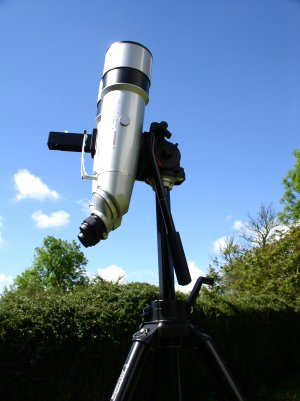
Whilst this may be as high as you can comfortably observe with "straight through"
binoculars, those with 45° eyepieces can comfortably observe to the zenith.
Photo- and video- heads are usually designed to permit the camera to point
straight down, so the trick is to reverse the head and put the binoculars on the
"wrong" way:
Any handle on the
head will probably need to be reversed, and may therefore get in the way of
tension controls, clamp levers, etc.
A consideration with large, heavy
binoculars is that the centre of mass of the binoculars is some distance from
the altitude fulcrum of the head so, at altitude, there is a considerable
turning moment on the head. Any altitude tension control may need to be set at or
near maximum. This, combined with the cantilevered weight of the binocular, can
make the the set-up awkward to use.
Parallelogram Mounts
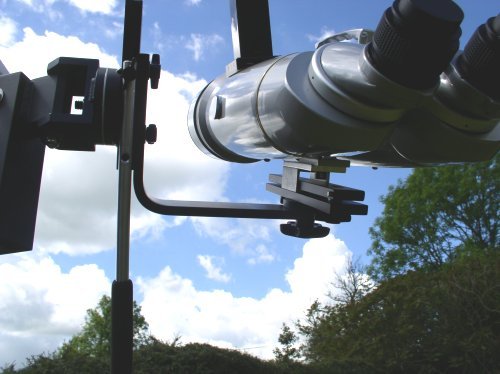
Parallelogram mounts (P-mounts) offer a great deal of versatility. They are often cited as advantageous for star-parties or other group observations, because they permit the height of the eyepieces to be changed without changing the target object, but the same is true (albeit to a lesser extent) of centre-post tripods. Basic incarnations of P-mounts may require that the binocular is pointed back over the tripod, but there are sophisticated designs that are much more flexible; the epitome of these is the Universal Astronomics deluxe mounting head (right).
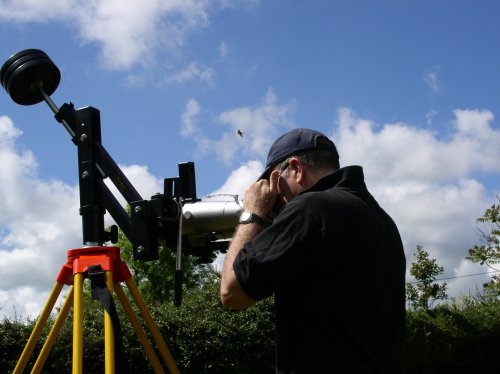
This permits the binocular to be adjusted so that its centre of mass is exactly aligned with the
altitude fulcrum, so that the binocular does not exert a turning moment on the
fulcrum. The consequence of this, together with the counter-weighting, is that
the the binocular feels almost as though it is floating in the air.
Additionally, the additional azimuth fulcrum permits the binocular to be pointed
at a very large proportion of the sky (about a third of it) without any
significant change of observing position.
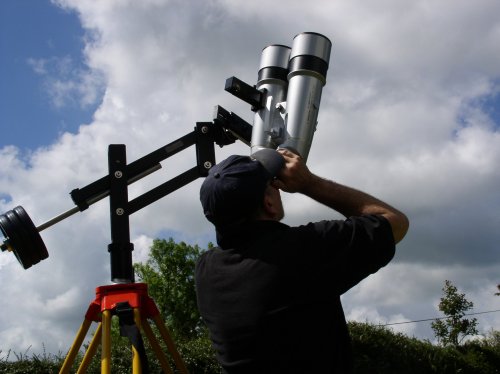
This high degree of flexibility is obviously a consideration if you prefer to observe sitting down:
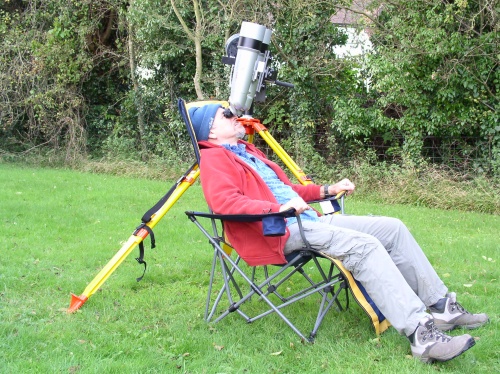
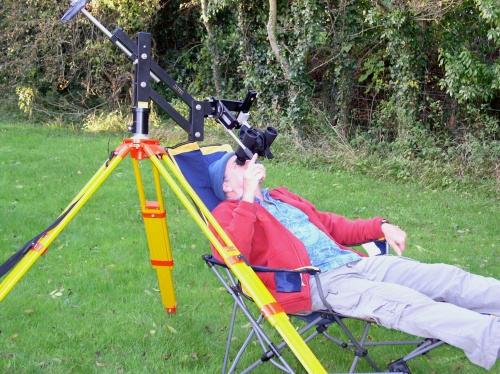
The mount shown to the left is the Universal
Astronomics T-mount,
a short parallelogram, mounted on a standard surveying tripod. Longer parallelograms can permit
reclining, seated, and standing observation from the same tripod height. The
consequence is a much longer turning moment on the tripod and support, resulting
in vibrations taking longer to damp.
P-mounts are amenable to
home-construction if you have woodworking skills; see the links below.
Other Mounting Options
Paragon-Plus A basic commerically available parallelogram that is good for binoculars up to about 2.3kg (5 lb) and usable up to about 3.5kg. It fits to a photographic tripod; also available with a tripod. (For USA availablity, see here (without tripod) and here (with tripod))
CloudyNights Reviews of Binocular Mounts
Comet Couch
Florian's Binocular Viewing Accessories (includes a home-made mirror mount)
Craig Simmons' Binocular Chair
Parallelogram Binocular Mount (good, simple P-mount with full construction plans)
Scott's Binocular Mount Page (excellent, versatile home-made P-mount)
Sky Window (commercially made mirror mount)
Star Chair (the ultimate observing chair!)

